The Inverse Optimization of Lithographic Source and Mask via GA-APSO Hybrid Algorithm
Abstract
1. Introduction
2. Methodology
2.1. Partially Coherent Imaging Model
2.2. Source and Mask Optimization Using GA-APSO Algorithm
- (1)
- Initialization of the population
- (2)
- Population update by APSO
- (3)
- Crossover operator
- (4)
- Mutation operator
- (1)
- Initialization
- (2)
- Source optimization
- (3)
- Mask optimization
3. Simulations and Discussion
3.1. Simulation Parameters
3.2. Simulation Results
3.3. Discussion
4. Conclusions
Author Contributions
Funding
Institutional Review Board Statement
Informed Consent Statement
Data Availability Statement
Conflicts of Interest
References
- Liebmann, L.W. Resolution enhancement techniques in optical lithography: It’s not just a mask problem. In Photomask and Next-Generation Lithography Mask Technology VIII; SPIE: St Bellingham, WA, USA, 2001; Volume 4409, pp. 23–32. [Google Scholar] [CrossRef]
- Bukofsky, S. Optimum mask and source patterns to print a given shape. J. Micro/Nanolithography MEMS MOEMS 2002, 1, 13. [Google Scholar] [CrossRef]
- Chen, W.H.; He, J.F.; Dong, L.S.; Wei, Y.Y. Mechanism and Applications of Source Mask Optimization. Semicond. Technol. 2017, 42, 641–649. [Google Scholar] [CrossRef]
- Socha, R. Freeform and SMO. In Optical Microlithography XXIV; SPIE: St Bellingham, WA, USA, 2011; Volume 7973, pp. 19–35. [Google Scholar] [CrossRef]
- Jia, N.; Lam, E.Y. Pixelated source mask optimization for process robustness in optical lithography. Opt. Express 2011, 19, 19384–19398. [Google Scholar] [CrossRef] [PubMed]
- Li, J.; Lam, E.Y. Robust source and mask optimization compensating for mask topography effects in computational lithography. Opt. Express 2014, 22, 9471–9485. [Google Scholar] [CrossRef] [PubMed]
- Ma, X.; Han, C.; Li, Y.; Dong, L.; Arce, G.R. Pixelated source and mask optimization for immersion lithography. J. Opt. Soc. Am. A 2012, 30, 112–123. [Google Scholar] [CrossRef] [PubMed]
- Peng, Y.; Zhang, J.; Wang, Y.; Yu, Z. High performance source optimization using a gradient-based method in optical lithography. In Proceedings of the 2010 11th International Symposium on Quality Electronic Design (ISQED), San Jose, CA, USA, 22–24 March 2010; pp. 108–113. [Google Scholar] [CrossRef]
- Ma, X.; Dong, L.; Han, C.; Gao, J.; Li, Y.; Arce, G.R. Gradient-based joint source polarization mask optimization for optical lithography. J. Micro/Nanolithography MEMS MOEMS 2015, 14, 023504. [Google Scholar] [CrossRef]
- Yu, J.-C.; Yu, P. Gradient-based fast source mask optimization (SMO). In Optical Microlithography XXIV; SPIE: St Bellingham, WA, USA, 2011; Volume 7973, pp. 681–693. [Google Scholar] [CrossRef]
- Sivanandam, S.N. Introduction to Genetic Algorithms; Springer: Berlin/Heidelberg, Germany, 2008. [Google Scholar] [CrossRef]
- Fuhner, T.; Erdmann, A.; Schnattinger, T. Genetic algorithms for geometry optimization in lithographic imaging systems. In Applications of Digital Image Processing XXVII; SPIE: St Bellingham, WA, USA, 2004; pp. 29–40. [Google Scholar] [CrossRef]
- Erdmann, A.; Fuehner, T.; Schnattinger, T.; Tollkuehn, B. Toward automatic mask and source optimization for optical lithography. In Optical Microlithography XVII; SPIE: St Bellingham, WA, USA, 2004; pp. 646–657. [Google Scholar] [CrossRef]
- Fühner, T.; Erdmann, A.; Seifert, S. Direct optimization approach for lithographic process conditions. J. Micro/Nanolithography MEMS MOEMS 2007, 6, 031006. [Google Scholar] [CrossRef]
- Fühner, T.; Erdmann, A.; Evanschitzky, P. Simulation-based EUV source and mask optimization. In Photomask Technology; SPIE: St Bellingham, WA, USA, 2008; Volume 7122, pp. 651–664. [Google Scholar] [CrossRef]
- Yang, C.; Wang, X.; Li, S.; Erdmann, A. Source mask optimization using real-coded genetic algorithms. In Optical Microlithography XXVI; SPIE: St Bellingham, WA, USA, 2013; Volume 8683, pp. 570–583. [Google Scholar] [CrossRef]
- Navid Razmjooy, M.A.; Foroozandeh, Z. (Eds.) Metaheuristics and Optimization in Computer and Electrical Engineering; Springer: Cham, Switzerland, 2021. [Google Scholar] [CrossRef]
- Wang, L.; Li, S.; Wang, X.; Yan, G.; Yang, C. Pixelated source optimization for optical lithography via particle swarm optimization. J. Micro/Nanolithography MEMS MOEMS 2016, 15, 013506. [Google Scholar] [CrossRef]
- Zhang, Z.; Li, S.; Wang, X.; Cheng, W.; Qi, Y. Source mask optimization for extreme-ultraviolet lithography based on thick mask model and social learning particle swarm optimization algorithm. Opt. Express 2021, 29, 5448–5465. [Google Scholar] [CrossRef] [PubMed]
- Sun, H.; Du, J.; Jin, C.; Feng, J.; Wang, J.; Hu, S.; Liu, J. Global Source Optimisation Based on Adaptive Nonlinear Particle Swarm Optimisation Algorithm for Inverse Lithography. IEEE Photon-J. 2021, 13, 1–7. [Google Scholar] [CrossRef]
- Wong, A.K. Optical Imaging in Projection Microlithography; SPIE: St Bellingham, WA, USA, 2005. [Google Scholar] [CrossRef]
- Chen, G.; Li, S.; Wang, X. Source mask optimization using the covariance matrix adaptation evolution strategy. Opt. Express 2020, 28, 33371–33389. [Google Scholar] [CrossRef] [PubMed]
- Poonawala, A.; Milanfar, P. A pixel-based regularization approach to inverse lithography. Microelectron. Eng. 2007, 84, 2837–2852. [Google Scholar] [CrossRef]

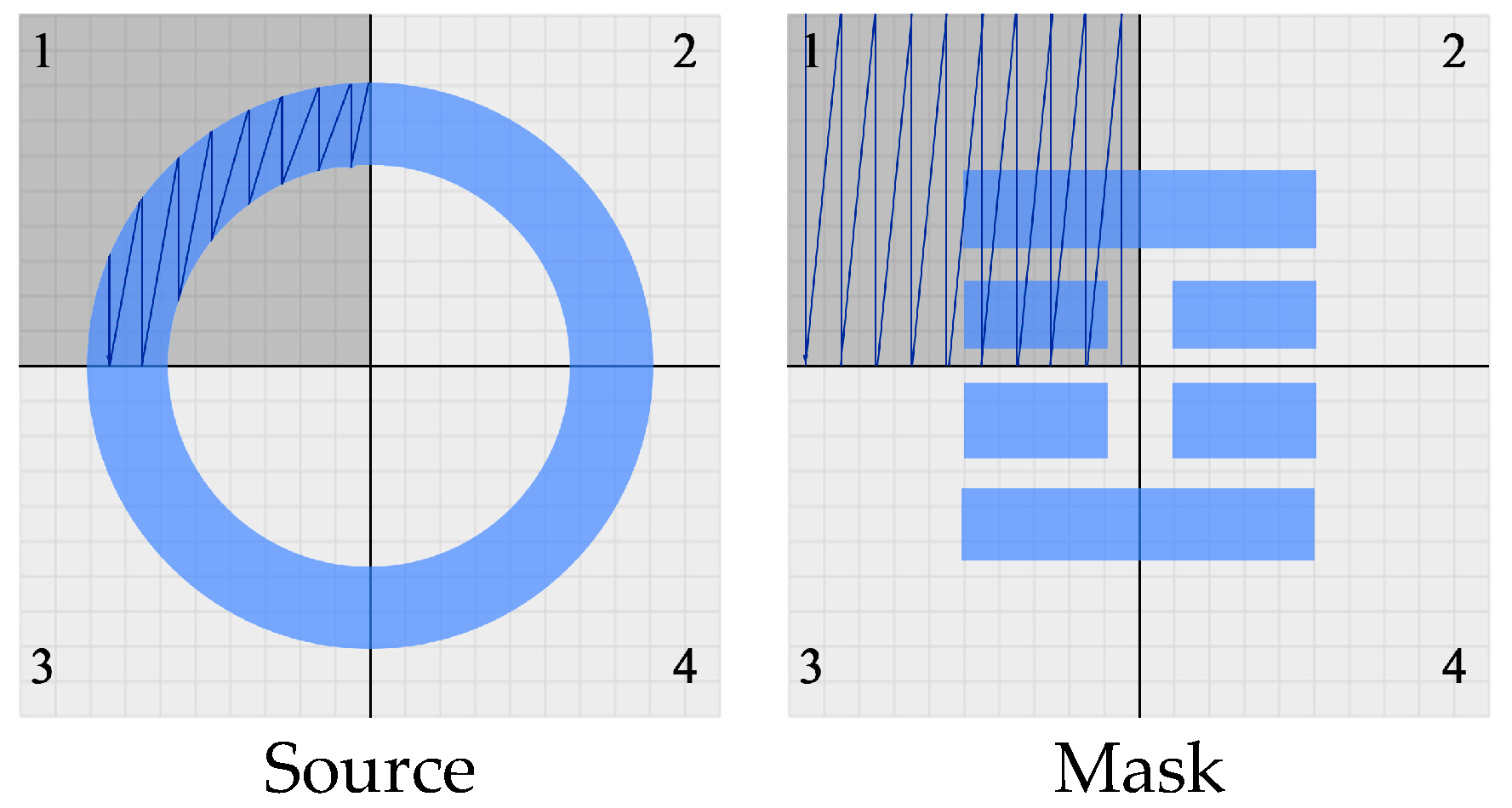





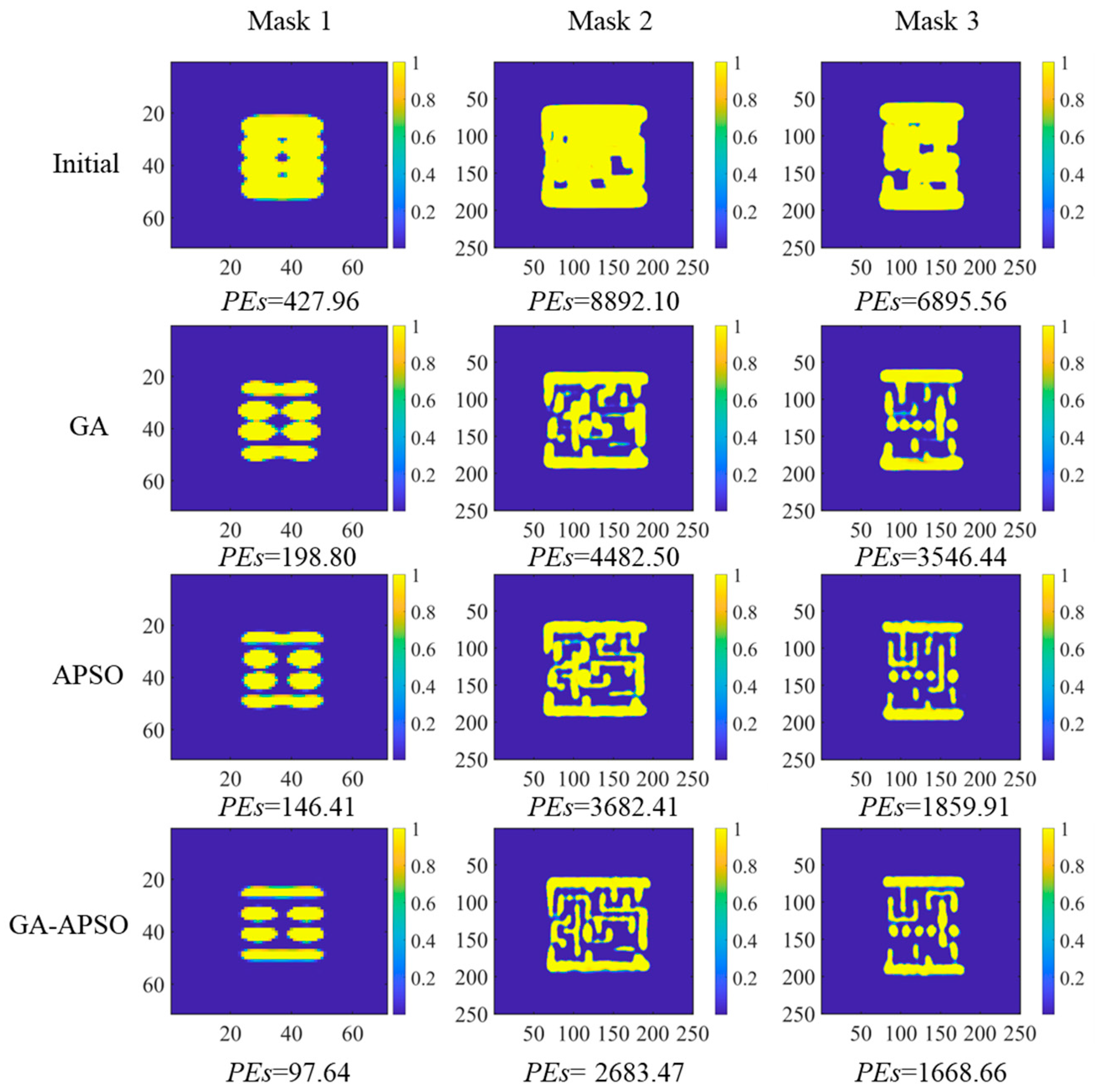
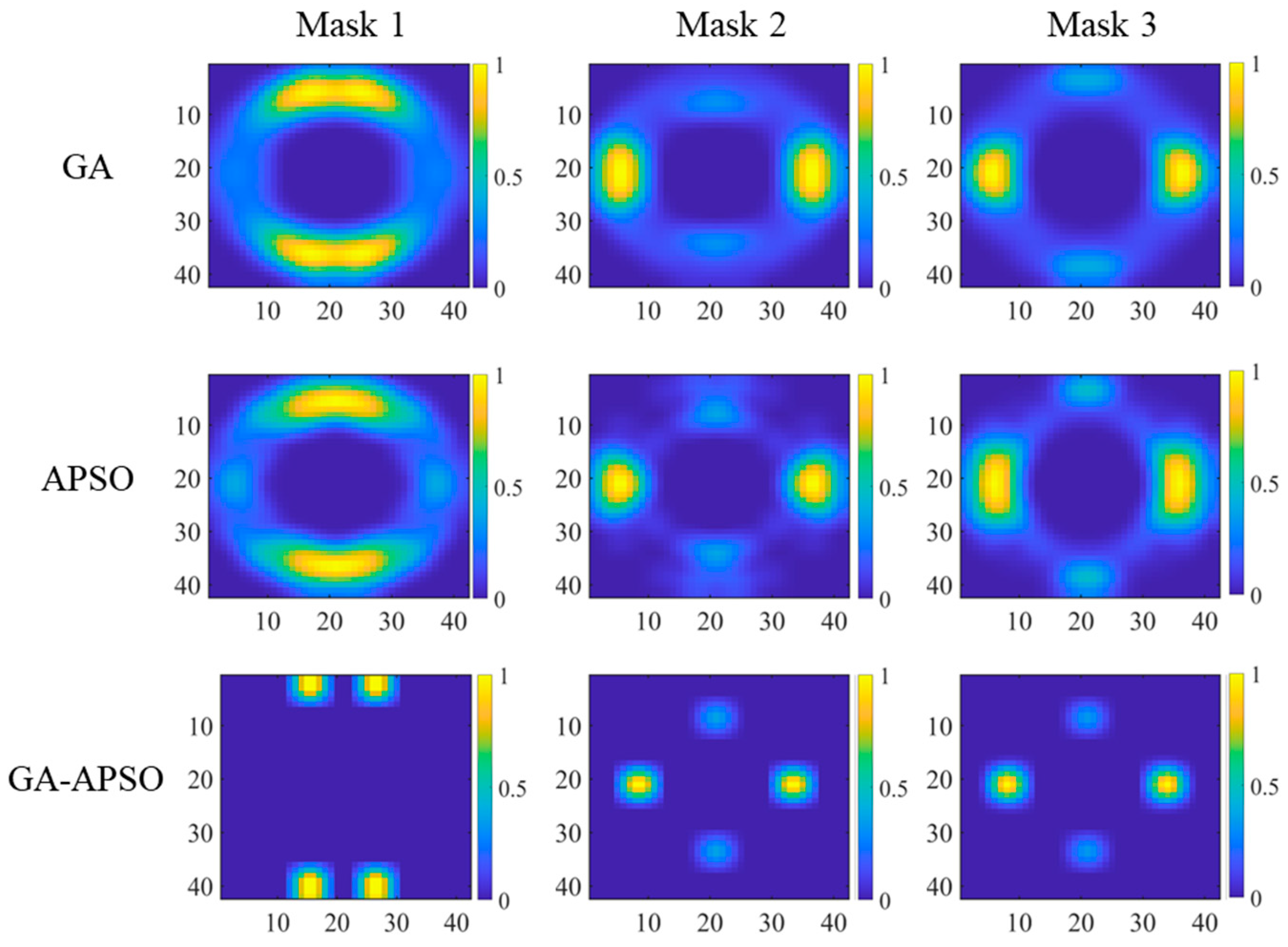


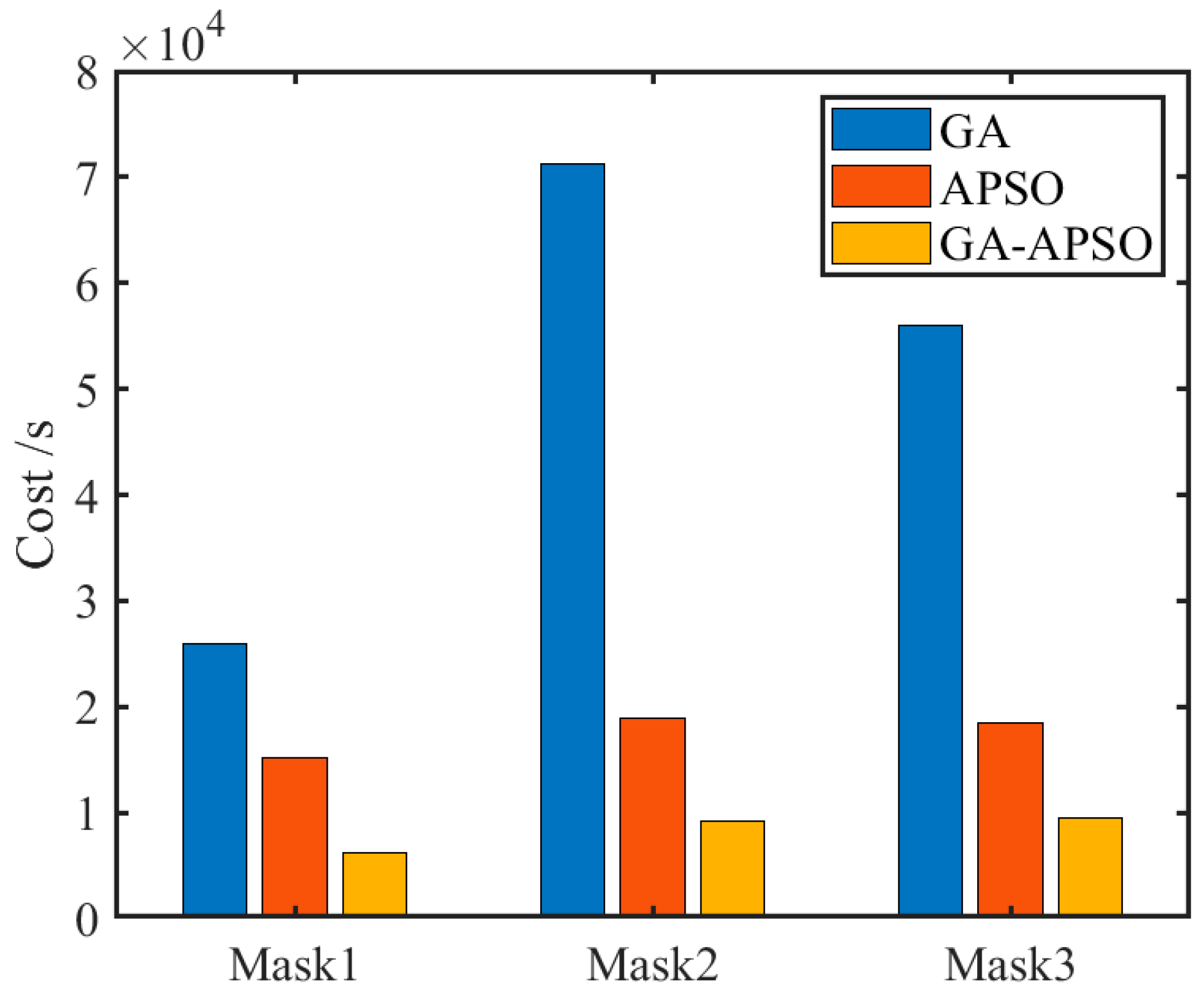


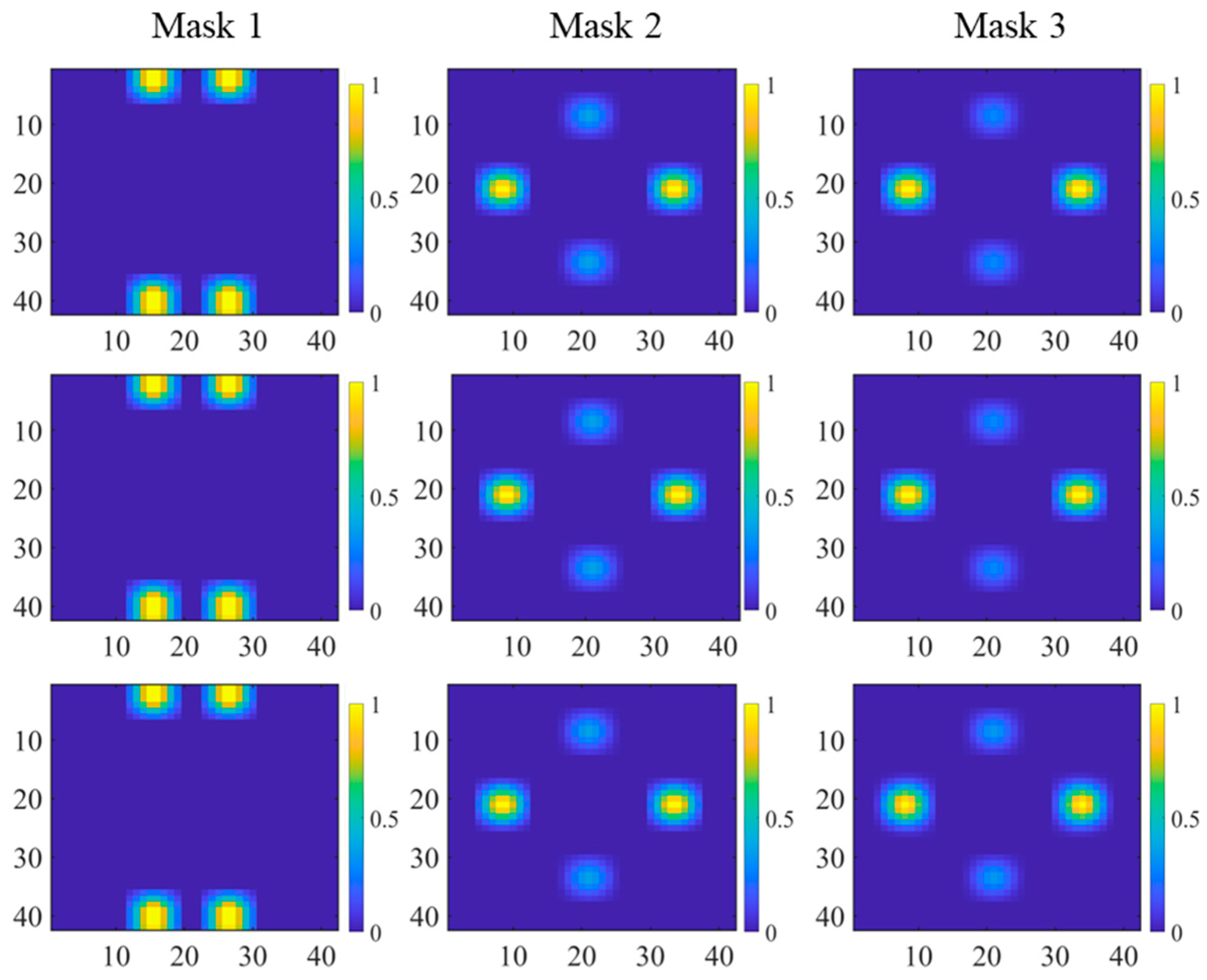
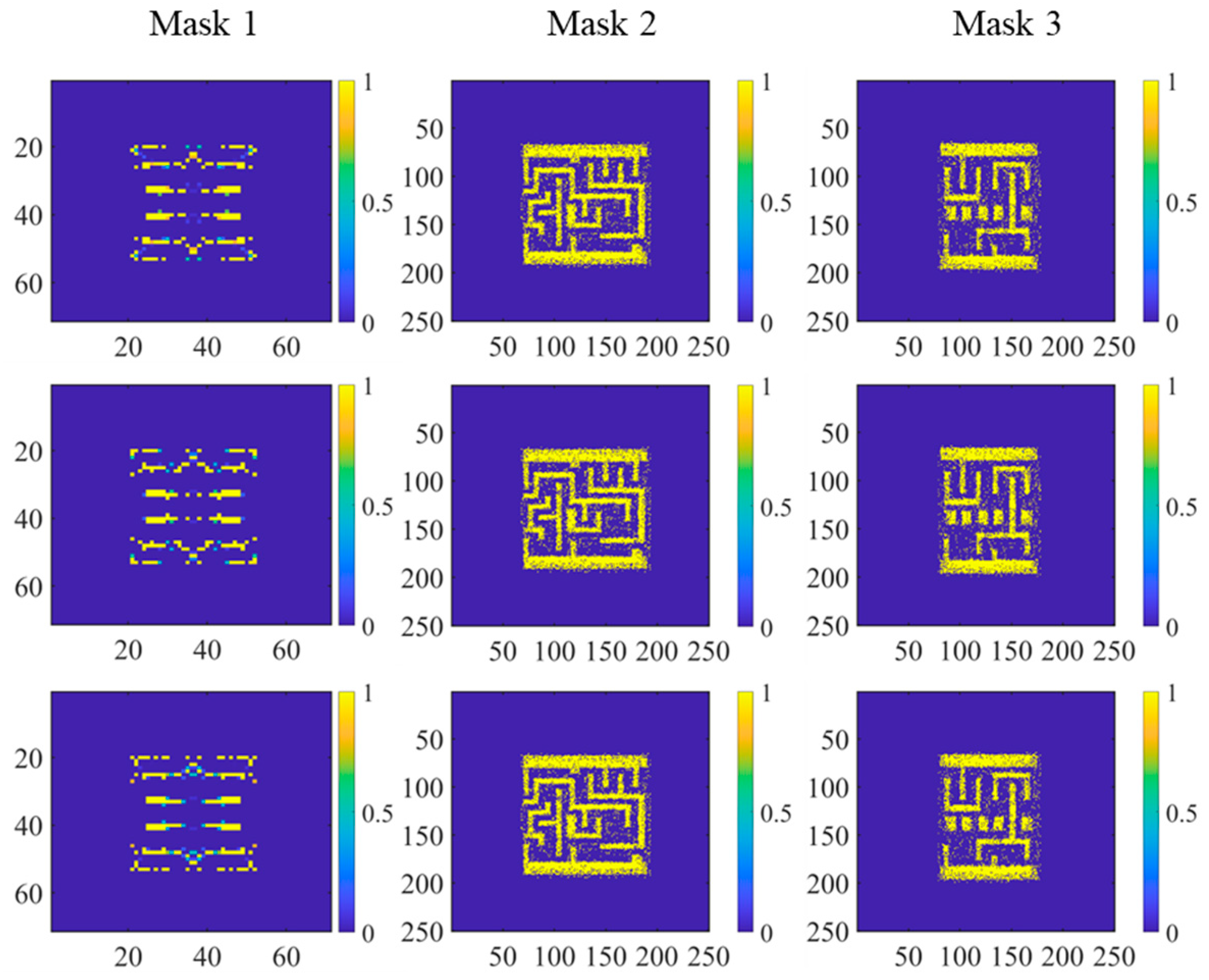
| Parameter | Value |
|---|---|
| Maximum and minimum individual learning factor c1 | 1.5/2 |
| Maximum and minimum social learning factor c2 | 1.5/2 |
| Maximum and minimum inertia weight factor w | 0.1/1 |
| Maximum and minimum velocity v | −1/1 |
| Crossover probability pc | 0.8 |
| Mutation probability pm | 0.2 |
| Case 1 | Case 2 | Case 3 | Standard Deviation | |
|---|---|---|---|---|
| MASK1 | 97.64 | 98.07 | 97.72 | 0.19 |
| MASK2 | 2683.47 | 2553.54 | 2815.82 | 107.08 |
| MASK3 | 1668.66 | 1736.08 | 1703.34 | 27.52 |
Disclaimer/Publisher’s Note: The statements, opinions and data contained in all publications are solely those of the individual author(s) and contributor(s) and not of MDPI and/or the editor(s). MDPI and/or the editor(s) disclaim responsibility for any injury to people or property resulting from any ideas, methods, instructions or products referred to in the content. |
© 2023 by the authors. Licensee MDPI, Basel, Switzerland. This article is an open access article distributed under the terms and conditions of the Creative Commons Attribution (CC BY) license (https://creativecommons.org/licenses/by/4.0/).
Share and Cite
Liu, J.; Zhou, J.; Sun, H.; Jin, C.; Wang, J.; Hu, S. The Inverse Optimization of Lithographic Source and Mask via GA-APSO Hybrid Algorithm. Photonics 2023, 10, 638. https://doi.org/10.3390/photonics10060638
Liu J, Zhou J, Sun H, Jin C, Wang J, Hu S. The Inverse Optimization of Lithographic Source and Mask via GA-APSO Hybrid Algorithm. Photonics. 2023; 10(6):638. https://doi.org/10.3390/photonics10060638
Chicago/Turabian StyleLiu, Junbo, Ji Zhou, Haifeng Sun, Chuan Jin, Jian Wang, and Song Hu. 2023. "The Inverse Optimization of Lithographic Source and Mask via GA-APSO Hybrid Algorithm" Photonics 10, no. 6: 638. https://doi.org/10.3390/photonics10060638
APA StyleLiu, J., Zhou, J., Sun, H., Jin, C., Wang, J., & Hu, S. (2023). The Inverse Optimization of Lithographic Source and Mask via GA-APSO Hybrid Algorithm. Photonics, 10(6), 638. https://doi.org/10.3390/photonics10060638





